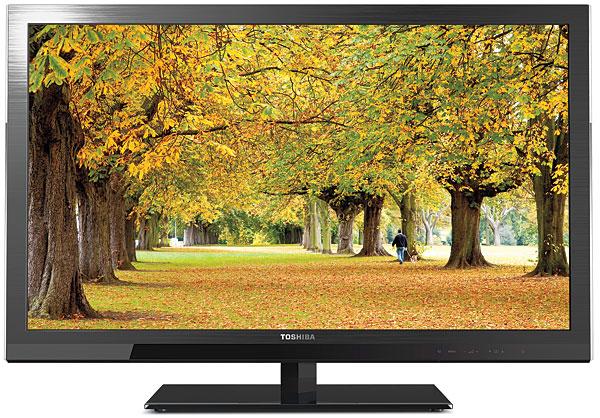Toshiba 55TL515U 3D LCD HDTV

The last three flat-panel HDTVs reviewed in these pages averaged over $4,000 each—a figure inflated, to be sure, by one of them costing $6,000. Statement products tell us what’s possible and where the technology is going. Most Home Theater readers want to know these things.
But the reality for most folks is that even in these days of continually dropping HDTV prices, $2,000 is the mark of an expensive television. And Toshiba hopes it has your number. At $1,800 (and we’ve seen it heavily discounted), the 55-inch 55TL515U offers 3D using passive glasses and a host of other features. While it may be a bit short on the cutting-edge technology that distinguishes its much pricier competition (Toshiba will no doubt disagree!), it appears at first glance to offer a lot of bang for the buck. But does it? We’ll find out.
Outside and Inside
There’s nothing cosmetic to distinguish the styling of the slim Toshiba from its competition. That’s not necessarily a bad thing, of course, as the set won’t dominate its surroundings. The black bezel is of average width (just over 1.5 inches wide at the sides). And some readers will be happy to hear that the screen, while not as totally matte-finished as the (special order) MacBook Pro I’m typing this review on, is far less reflective than many of today’s flat-panel sets.
Around back is a typical complement of inputs and outputs, including four HDMI terminals and two USB ports. Special breakout cables are required (and included) for many of the non-digital inputs, including the component and composite jacks. That’s the price demanded by a slim panel design, which in this case is just over an inch thick.
There’s the usual range of picture modes here. Unlike some 3D sets, the Toshiba does not offer separate settings in a given mode for 2D and 3D sources. I used the Movie 2 mode for 2D and Movie 1 for 3D. The set doesn’t switch between those modes when it senses 2D or 3D, either; you have to do that yourself.
Most of the specialized controls are found in the Advanced Picture Settings submenu. Those best left off (for me) include the Auto Brightness Sensor (compensates for changes in room lighting) Dynamic Contrast, Noise Reduction, and Edge Enhancer.
ColorMaster is Toshiba’s color management system that offers base color adjustments (hue, saturation, and brightness) for the primary (red, green, blue) and secondary (yellow, cyan, magenta) colors. The Color Temperature control offers 11 steps from zero to 10.
Toshiba claims local dimming for the 55TL515U. The set employs LED edge lighting, which operates dynamically when the DynaLight control is engaged. But I saw no visible evidence of dimming by zones, which is difficult to do with edge lighting. Fully effective local dimming requires the use of many clusters of LEDs behind the screen, not a few clusters at its sides. This is what we call full-array local-dimming, and it appears on the best LCDs we’ve tested.

ClearScan 240 is Toshiba’s motion interpolation feature. As with similar features found in virtually all modern LCD sets (and now some plasmas), it significantly smoothes out the lag and smear common to LCD on rapid motion. But the trade-off here (for me) is an unnaturally silky look to moving objects. Sometimes called the soap opera effect, it can be particularly annoying—or at least unnatural—on film-based material.
Toshiba says the Smooth setting of the separate Film Stabilization control turns on 5:5 pulldown for 24fps sources. Oddly, I saw similarly excessive smoothing with this control in that position—even when ClearScan 240 was off. And it was just as unpleasant as ClearScan 240 for those of us who dislike what motion interpolation does to the look of films.
(Keen-eyed readers may deduce that 5:5 pulldown implies a 120-hertz refresh rate with 24fps sources, not 240 Hz. Some Toshiba sets in the past have used a 120 Hz refresh, and by scanning the backlighting—or here the edge lighting—they create a 240Hz effect. At press time, Toshiba had not yet provided us with confirmation of the set’s true refresh rate.)
Another submenu, Expert Picture Settings, includes a single test pattern (color), the RGB-only filters (which simplify setting the color and tint controls without the need for external filters), and the 2-point (high and low) white balance controls.
The Toshiba can connect to a home network either wired or wireless. No adapter is required for the wireless option (not tested). You can access the set’s NET TV features via the Internet. These were limited, as far as I could tell, to YouTube, various Yahoo Widgets, and Netflix.
- Log in or register to post comments



































































